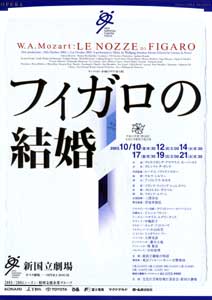|
 This popular opera,
adored by people throughout the This popular opera,
adored by people throughout the
world, will soon be performed on the stage of the NNTT. The
performance will mark the beginning of an operatic journey
that begins with Mozart travels through to the twentieth century.
The 2003/2004 season, which welcomes Thomas Novohradsky from
Vienna as Artistic Director, features the theme of “the
fate of men.” In this journey, men experience everyday
life, sometimes have their mind and soul agitated, travel
through mysterious dream worlds, and by the final performance
of the season, come to take a philosophic view of their lives
through various experiences. We hope you look forward to the
results of the diverse creative activities of the staff members
and cast of singers involved in the production of operas,
who interpret and depict “the fate of men” from
their own unique perspectives,.
The season begins with Mozart’s masterpiece Le Nozze
di Figaro (The Marriage of Figaro). Since its Viennese premiere
in 1786, this most popular of popular operas has continued
to be performed as an important part of the repertoire of
opera houses throughout the world, and its performance is
always eagerly awaited by audiences. [In the opera,] the Count
schemes to restore the privileges of men ; the Countess laments
his fickleness and looks back nostalgically to a happier past;
Cherubino is infatuated like an adolescent boy; Susanna is
jaunty and witty; and Figaro goes through all the feelings
of joy and anger among these people. Characters of various
classes appear on the stage, one after another, and their
dizzy lives are vividly portrayed as events in a “mad
day.” Beginning with a lilting overture, the opera is
filled with outstanding arias, such as “Voi che sapete
(You who know)” by Cherubino and “Non piu andrai
(No longer will you go)” by Figaro, as well as “Porgi
amor…(Grant, love…)” and “Dove sono
i bei momenti (Where are the golden moments)” by the
Countess. And the ensemble, the best part of the work, adorns
the finale of the last act. There is really no end to the
list of this opera’s highlights.
The collaboration between Andreas Homoki, a leading contemporary
opera director, and Ulf Schirmer, a conductor who has deep
insights into the score, entices the audience into the world
of Mozart, which is filled with wonder and discoveries. The
fresh, new cast of singers carefully devises the dramatic
development through the ensembles, capturing the hearts of
the audience. Please enjoy to the fullest this operatic journey
that begins with Mozart.
<Synopsis>
Formerly a
barber and now a valet to Count Almaviva, Figaro is about
to marry the Countess’s maid Susanna. Although the Count
had abandoned his feudal right to sleep with her on her first
night of marriage, he intends to restore it in order to seduce
her. The Countess, meanwhile, laments that her husband’s
love for her is fading. She conspires with Figaro and Susanna
to outwit the Count and attempts to lure him away by disguising
the fickle page Cherubino as a woman…
|
![]()
 This popular opera,
adored by people throughout the
This popular opera,
adored by people throughout the